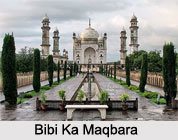 Aurangabad is an old city ("City of Gates") in Aurangabad District of West Indian state Maharashtra. This capital city of late Mughals earned prominence because of the monuments with intricate Mughal art and architecture initiated by last independent Mughal Emperor Aurangzeb. Now this city is connected with all Indian states by Aurangabad Airport.
Aurangabad is an old city ("City of Gates") in Aurangabad District of West Indian state Maharashtra. This capital city of late Mughals earned prominence because of the monuments with intricate Mughal art and architecture initiated by last independent Mughal Emperor Aurangzeb. Now this city is connected with all Indian states by Aurangabad Airport.
Location of Aurangabad
Aurangabad is located in the northern part of Maharashtra. It is placed at a distance of 375 km from the capital city Mumbai.
History of Aurangabad
Aurangabad has its long drawn history from the time of medieval age. In 1653, Aurangabad became the epicenter of Mughal Dynasty after Delhi, when prince Aurangazeb became the Governor of Deccan. He developed Fatehnagar and renamed it to Aurangabad. After the death of Aurangzeb in 1707, Aurangabad entered in the political hemisphere of Maratha Empire and Nizams of Hyderabad. During the rule of British Empire, Aurangabad became part of Hyderabad till Independence.
Geography of Aurangabad
Aurangabad is brilliantly environed by the rugged hills of Western Ghats Mountain Ranges in India and Deccan Traps. The Kham River dissects Aurangabad which helps in irrigation. The latitudinal and longitudinal limit of Aurangabad is 19 degree 53 minutes 47second north to 75 degree 23 minutes 54 second east.
 Climate of Aurangabad
Climate of Aurangabad
The "Tourism Capital of Maharashtra" enjoys tropical semi-arid steppe climate. The summer temperature ranges from 30 degree Celsius to 46 degree Celsius and the winter temperature ranges from 2 degree Celsius to 14 degree Celsius.
Demography of Aurangabad
According to the Population census in the year 2011, the population of Aurangabad is about 1,171,260. It is the fifth populous city in Maharashtra after Mumbai, Pune, Nashik and Nagpur.
Administration of Aurangabad
Aurangabad is administered under Aurangabad Division. Aurangabad Municipal Corporation is responsible for the development and the maintenance of this west Indian city.
Culture of Aurangabad
The culture is similar to the culture of Maharashtra and Hyderabadi culture. The old city has the flavours of Andhra Pradesh cuisine and the Urdu literature. Dakhni cuisine is a popular cuisine, which is a blend of Puneri and the Hyderabadi cuisine. Aurangabad is also popular for large number of fairs and festivals which is the economy generator of this city.
Economy of Aurangabad
This city is now emerged as the Information Technology hub after Mumbai. It serves as a major trade route to western India. Aurangabad is also a hub of silk and cotton textiles and retail industries.
Tourism in Aurangabad
Aurangabad is dotted with many tourism destinations like Ellora and Ajanta Caves, Bibi Ka Maqbara, Daulatabad Fort, Panchakki, Salim Ali Lake, Aurangabad Caves, Grishneshwar Temple, Salim Bird Sanctuary, Tomb of Aurangzeb, Chintamani Parshvanatha Digambar and Siddharth Garden and Zoo.



















